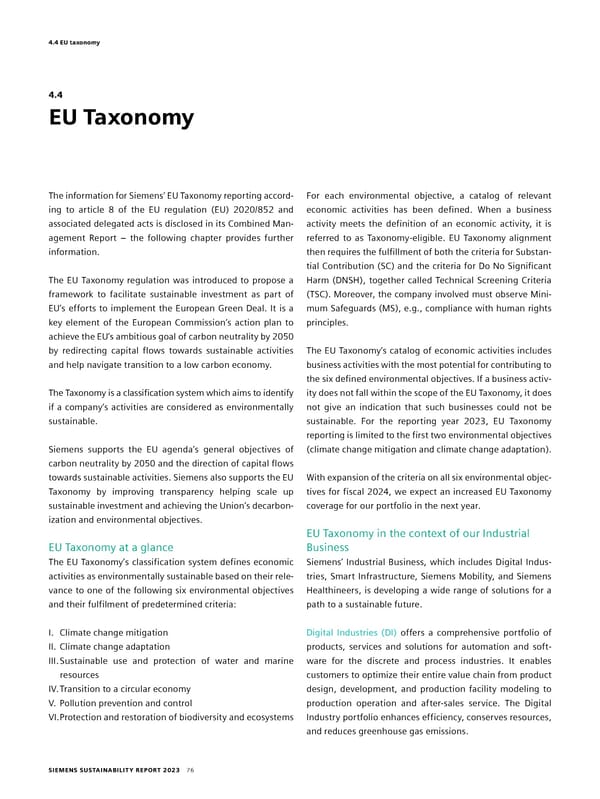4.4 EU taxonomy 4.4 EU Taxonomy The information for Siemens’ EU Taxonomy reporting accord- For each environmental objective, a catalog of relevant ing to article 8 of the EU regulation (EU) 2020/852 and economic activities has been defined. When a business associated delegated acts is disclosed in its Combined Man- activity meets the definition of an economic activity, it is agement Report – the following chapter provides further referred to as Taxonomy-eligible. EU Taxonomy alignment information. then requires the fulfillment of both the criteria for Substan- tial Contribution (SC) and the criteria for Do No Significant The EU Taxonomy regulation was introduced to propose a Harm (DNSH), together called Technical Screening Criteria framework to facilitate sustainable investment as part of (TSC). Moreover, the company involved must observe Mini- EU’s efforts to implement the European Green Deal. It is a mum Safeguards (MS), e.g., compliance with human rights key element of the European Commission’s action plan to principles. achieve the EU’s ambitious goal of carbon neutrality by 2050 by redirecting capital flows towards sustainable activities The EU Taxonomy’s catalog of economic activities includes and help navigate transition to a low carbon economy. business activities with the most potential for contributing to the six defined environmental objectives. If a business activ- The Taxonomy is a classification system which aims to identify ity does not fall within the scope of the EU Taxonomy, it does if a company’s activities are considered as environmentally not give an indication that such businesses could not be sustainable. sustainable. For the reporting year 2023, EU Taxonomy reporting is limited to the first two environmental objectives Siemens supports the EU agenda’s general objectives of (climate change mitigation and climate change adaptation). carbon neutrality by 2050 and the direction of capital flows towards sustainable activities. Siemens also supports the EU With expansion of the criteria on all six environmental objec- Taxonomy by improving transparency helping scale up tives for fiscal 2024, we expect an increased EU Taxonomy sustainable investment and achieving the Union’s decarbon- coverage for our portfolio in the next year. ization and environmental objectives. EU Taxonomy in the context of our Industrial EU Taxonomy at a glance Business The EU Taxonomy’s classification system defines economic Siemens’ Industrial Business, which includes Digital Indus- activities as environmentally sustainable based on their rele- tries, Smart Infrastructure, Siemens Mobility, and Siemens vance to one of the following six environmental objectives Healthineers, is developing a wide range of solutions for a and their fulfilment of predetermined criteria: path to a sustainable future. I. Climate change mitigation Digital Industries (DI) offers a comprehensive portfolio of - II. Climate change adaptation products, services and solutions for automation and soft Sustainable use and protection of water and marine ware for the discrete and process industries. It enables III. resources customers to optimize their entire value chain from product IV. Transition to a circular economy design, development, and production facility modeling to V. Pollution prevention and control production operation and after-sales service. The Digital VI. Protection and restoration of biodiversity and ecosystems Industry portfolio enhances efficiency, conserves resources, and reduces greenhouse gas emissions. SIEMENS SUSTAINABILITY REPORT 2023 76
 Sustainability Report Page 75 Page 77
Sustainability Report Page 75 Page 77